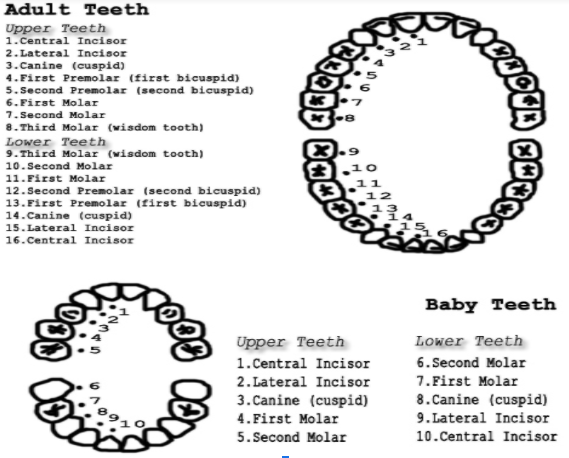
The primary dentition in humans differs from permanent dentition in not having one of the following types of teeth.
A. Incisors
B. Canine
C. Premolars
D. Molars
Answer
573.9k+ views
Hint: Human beings have two sets of dentitions in their lifetime. One temporary or milk teeth and other permanent or adult teeth. This type of dentition is called diphyodont.
Complete step-by-step answer:
1. Most of the children have 20 sets of teeth. Which include pairs of: central incisor, lateral incisor, canine, first molar and second molar. The dental formula is 2102/ 2012. (There are four quadrants of the teeth in the buccal cavity, which are the upper right, upper left, lower right, and lower left)
2. Whereas in adults there are 32 sets of teeth. Which includes a pair of: central incisor, lateral incisor, canine, first premolar, second premolar, first molar, second molar and third molar (wisdom teeth). The dental formula is 2123/ 2123.
3. When the first molar teeths fall off they are replaced by first premolar and when second molar teeth fall off they are replaced by second premolar and behind them erupts adult first molar, second molar and third molar teeth.
4. In human adults there are a total eight premolar teeth.
Additional information:

So, the correct answer is “Option C premolar ”.
Note:
1. Canines and incisors have sharp ends whereas the premolars have a large flat biting surface which helps in tearing and crushing food.
2. Incisors are eight in number and in the front centre of buccal cavity.
3. Adjacent to incisors are canines they are four in number.
4. Molars are the posterior-most/ backmost teeth in the buccal cavity and they total twelve in number. Molars help in grinding and chewing of food.
Complete step-by-step answer:
1. Most of the children have 20 sets of teeth. Which include pairs of: central incisor, lateral incisor, canine, first molar and second molar. The dental formula is 2102/ 2012. (There are four quadrants of the teeth in the buccal cavity, which are the upper right, upper left, lower right, and lower left)
2. Whereas in adults there are 32 sets of teeth. Which includes a pair of: central incisor, lateral incisor, canine, first premolar, second premolar, first molar, second molar and third molar (wisdom teeth). The dental formula is 2123/ 2123.
3. When the first molar teeths fall off they are replaced by first premolar and when second molar teeth fall off they are replaced by second premolar and behind them erupts adult first molar, second molar and third molar teeth.
4. In human adults there are a total eight premolar teeth.
Additional information:

So, the correct answer is “Option C premolar ”.
Note:
1. Canines and incisors have sharp ends whereas the premolars have a large flat biting surface which helps in tearing and crushing food.
2. Incisors are eight in number and in the front centre of buccal cavity.
3. Adjacent to incisors are canines they are four in number.
4. Molars are the posterior-most/ backmost teeth in the buccal cavity and they total twelve in number. Molars help in grinding and chewing of food.
Recently Updated Pages
Why are manures considered better than fertilizers class 11 biology CBSE

Find the coordinates of the midpoint of the line segment class 11 maths CBSE

Distinguish between static friction limiting friction class 11 physics CBSE

The Chairman of the constituent Assembly was A Jawaharlal class 11 social science CBSE

The first National Commission on Labour NCL submitted class 11 social science CBSE

Number of all subshell of n + l 7 is A 4 B 5 C 6 D class 11 chemistry CBSE

Trending doubts
Differentiate between an exothermic and an endothermic class 11 chemistry CBSE

10 examples of friction in our daily life

One Metric ton is equal to kg A 10000 B 1000 C 100 class 11 physics CBSE

Difference Between Prokaryotic Cells and Eukaryotic Cells

1 Quintal is equal to a 110 kg b 10 kg c 100kg d 1000 class 11 physics CBSE

State the laws of reflection of light




